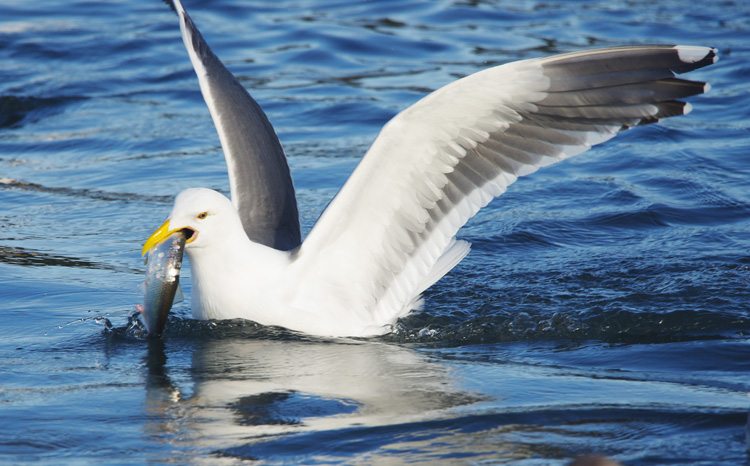In late winter each year, at select locations along the Oregon Coast, Pacific Herring spawn in huge numbers and attract a frenzy of fish-eating birds and marine mammals.
Herring and other “forage fish” form a critical link in marine and estuarine food webs. They feed on phytoplankton and zooplankton, and are major food sources for larger fish, seabirds, and marine mammals. Without healthy forage fish populations, the coastal commercial fisheries would be much smaller.
How often does a spawning happen?
The actual spawning event lasts less than a day, but the spectacle lasts for up to a month: from late February through late March.
Where does this happen?
The Herring seems to pick places with somewhat protected waters, and near reasonably deep channels. These places need suitable substrate, which can be subtidal rocks, eelgrass beds, kelps and other seaweeds.
In Oregon, the spawning generally happens in estuaries with jetties and channel maintenance.
Lower Tillamook Bay from the jetties at Barview and around Garibaldi, as well as Bay City are the most likely places in Tillamook County to host a spawning event. Lower Nehalem Bay is also a possibility.
Spawnings are visible events
First, the Herring gather into massive schools in the deeper water near the eventual spawning site.
If sea lions are in the area, they can be seen hunting the Herring, generally in groups of 20 or more animals. Occasionally, the Herring can be seen jumping out of the water to avoid the sea lions or larger fish. Gulls gather into flocks over the schools and plunge into the water to catch them when they come close enough to the surface. This pre-spawning activity can continue for a week or more.
Second, the Herring schools move up into shallower (but still subtidal) water to spawn. At this time, the gulls go wild: plunging into the water for the fish, and chasing each other to steal the ones already caught. Other birds join in including: loons, and cormorants.
The actual spawning lasts just one or two tide cycles, but may be repeated after 10-14 days. In the spawning, the females release eggs and the males release milt into the water just above suitable substrates. The eggs are sticky, and adhere to the jetty rocks or other rocky substrates, as well as to eelgrass or seaweed.
In the third phase, which lasts 10-14 days, other birds, primarily waterfowl, gather in large flocks to feed on the attached eggs. Harlequin Ducks feed along the rocks, diving to scrape the eggs off the rocks with their bills. Surf Scoters, Black Scoters, White-winged Scoters, Long-tailed Ducks, and Greater Scaup dive to pluck the egg-laden eelgrass and seaweed. The scoters gather into large flocks out in deeper water, then swim en masse over the eelgrass beds and dive simultaneously.
*The accompanying photos are from spawning events in Yaquina Bay in 2015 and 2016, but likely Tillamook Bay will see the same action.
